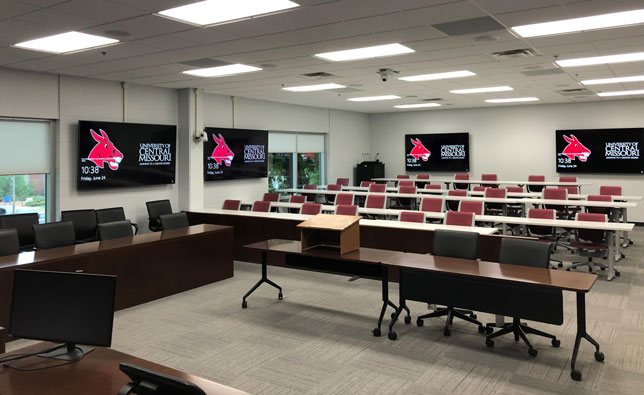U Central Missouri Upgrades Classrooms with AI- and AR-Enabled Tech for Hybrid Learning

Hybrid-ready classroom at the University of Central Missouri
The University of Central Missouri is updating its classrooms with new AV technologies that use artificial intelligence and augmented reality to capture more engaging, flexible presentations and better serve the needs of hybrid learning. The institution partnered with AV services provider AVI-SPL to implement Sony's Edge Analytics solution and SRG-X120 pan-tilt-zoom (PTZ) cameras as a new classroom standard across campus.
The rollout began with the installation of more than 30 Edge devices which, paired with Sony's PTZs, serve as a virtual camera operator for recording lectures. Edge offers a number of AI-powered features (some of which require the purchase of an individual license for activation):
- PTZ auto tracking, to automatically track a presenter and ensure they stay in focus and within frame;
- Handwriting extraction, which detects words and diagrams written on a board or screen and uses augmented reality to make sure the information remains in full view to the audience no matter where the speaker is standing;
- Chroma key-less CG overlay, which can extract the presenter's image and overlay it onto any background image, animation or video in real time; and
- Focus area cropping, which allows an image frame captured by a single camera to be viewed as two different output images simultaneously (for example, to show the presenter's head in a close-up next to the full video image).
UCM has opted to enable Edge's presenter tracking and handwriting extraction features, and is exploring the chroma key-less CG overlay in select classrooms. It plans to implement 14 additional systems going forward.
"Prior to the pandemic, UCM was seeing a shift in how it was delivering classroom content," explained Ray Walters, manager of multimedia at the university, in a statement. "At the same time, I was receiving numerous requests from academic deans and educators to enable hybrid classrooms where lectures could be recorded and presented in an asynchronous format …. When I was introduced to Sony's forward-thinking Edge Analytics device, it was a breath of fresh air. It solves several different needs for my classrooms as we pursue a hybrid teaching experience. The reasonable price and simple operation reduce the friction on users in the room. Sony had nailed everything I needed in one small package."
"It's a box with licenses that enhance the capabilities of your room, based on your needs and budget," noted David Gantz, account executive at AVI-SPL. "Instructors love the presenter tracking feature for whiteboarding and presenting. The tracking is very smooth and accurate and easy to teach someone to use. Adoption has gone really well because we've taken extra care not to make the room complex, because complexity deters instructors from wanting to use technology."
Gantz added that the technology gives UCM a competitive advantage in terms of student recruitment and engagement: "In order to attract students to a school, you need to offer collaboration and interactivity. Technology is something students were born with and use every day. They expect it to infiltrate every part of their life and education is no exception. By offering a new level of engagement, new capabilities and a digital mindset, students can overcome some of the traditional classroom concerns and distractions and ensure they have a good view of the instructor and their notes — no matter where they're sitting."
About the Author
Rhea Kelly is editor in chief for Campus Technology, THE Journal, and Spaces4Learning. She can be reached at [email protected].